Microblading: The Only Guide You Need
Learn all about what is microblading: effects, cost, side effects, aftercare, healing and more in our freshly updated guide. See examples of great works!
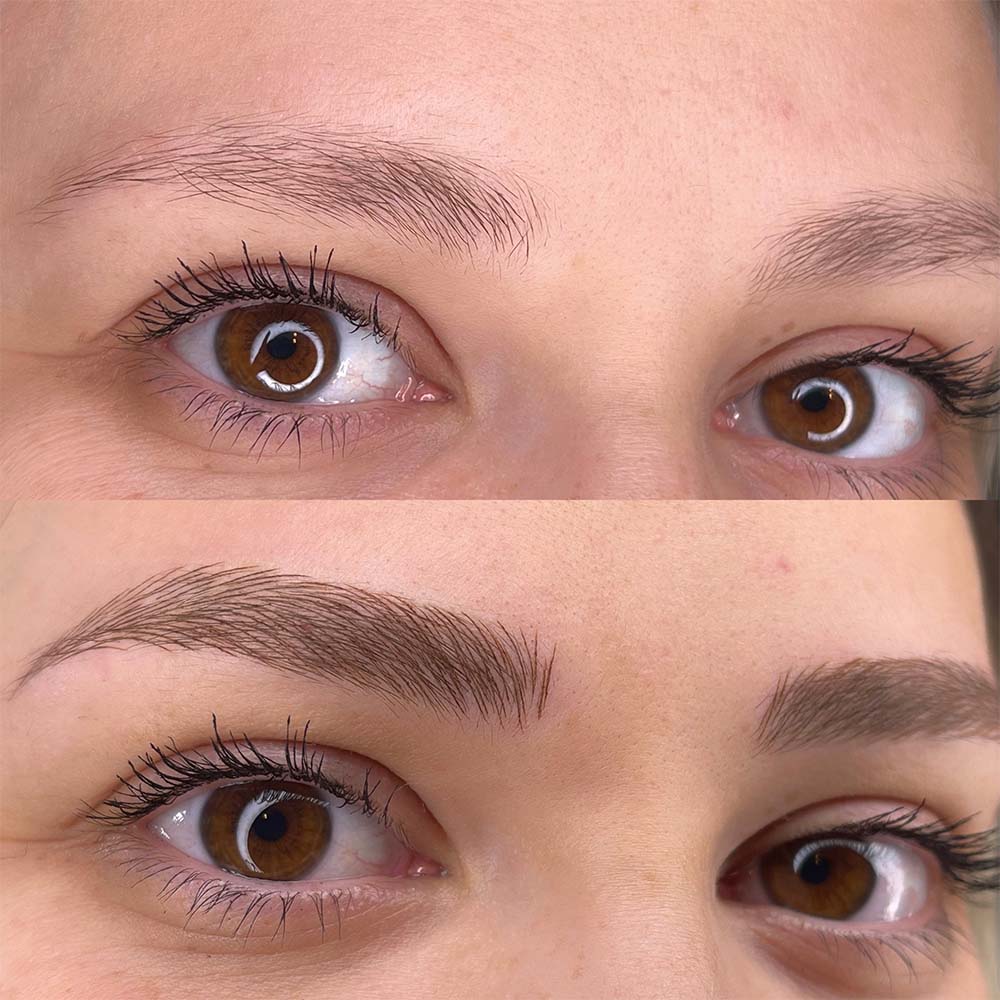
Image source : PMUhub
Explore more microblading topics
- Overview
- Healing Process
- Aftercare
- Before and After Gallery
- Cost USA
- Cost UK
- Cost Australia
- Cost South Africa
- Touch Up
- Scabbing
- For Oily Skin
- Combo Brows
- Combo Brows vs Microblading
- Feather Brows
- Microblading vs Brow Tattoo
- For Men
- Beard & Mustache
- For Blondes
- While Pregnant
- DIY
- Gone Wrong
- How Long Does It Last
- Fading
- Removal
- Consent Form
- Licensing USA
- Licensing Canada
- Licensing UK
- Licensing Australia
- Certification
- Insurance
Last updated in december 2022
Quick Facts
- Natural, hair-stroke effect
- Done with a manual blade
- Lasts 12-18 months
- Needs a 6-8 week touch up
- Average price ca. $600
Full, perfectly shaped eyebrows are by far the biggest beauty trend that is bound to stick around for a long time. The eyebrow microblading treatment gives you the arches you’ve always wanted, made-to-measure, thick, defined, yet perfectly natural-looking.
In our ultimate guide to eyebrow microblading, we will thoroughly explain everything you need to know about this highly-requested cosmetic tattoo procedure. Keep reading for answers to all your questions on microblading eyebrows!
- What Is Microblading?
- How Long Does Microblading Last?
- About Microblading Eyebrows
- About Microblading Procedure
- Microblading Healing Process
- Microblading Touch Up
- Microblading Side Effects
- Microblading Removal
- How Much Does Microblading Cost?
- Benefits Of Microblading
- Microblading Popularity
- Microblading – Main Takeways
What Is Microblading?
Microblading is a permanent makeup technique similar to eyebrow tattooing, but far more advanced. It is done manually, with a microblading tool – a blade consisting of several tiny needles – which is used to make thin incisions on the skin that look like natural brow hairs. They imitate the length, color, thickness and shape of the actual hairs.
Special pigments in the color of the natural hairs are then deposited into the skin, and the result is an illusion of thicker arches with a modified shape that best suits your face.
The results are very realistic and virtually unidentifiable, which is why this treatment is sometimes called 3D microblading.
How Long Does Microblading Last?
The estimated longevity is 12-18 months, after which the brows are mostly faded as the pigments are broken down by the body. At that point, they can be replenished.
For longer duration it is also necessary to follow the aftercare instructions prescribed by the microblading artist and to avoid certain cosmetic products which ingredients can speed up the fading.
Also, people with dry skin can expect their brows to last longer. People with oily skin might need frequent touch ups if they want to prolong the duration of their microbladed eyebrows.
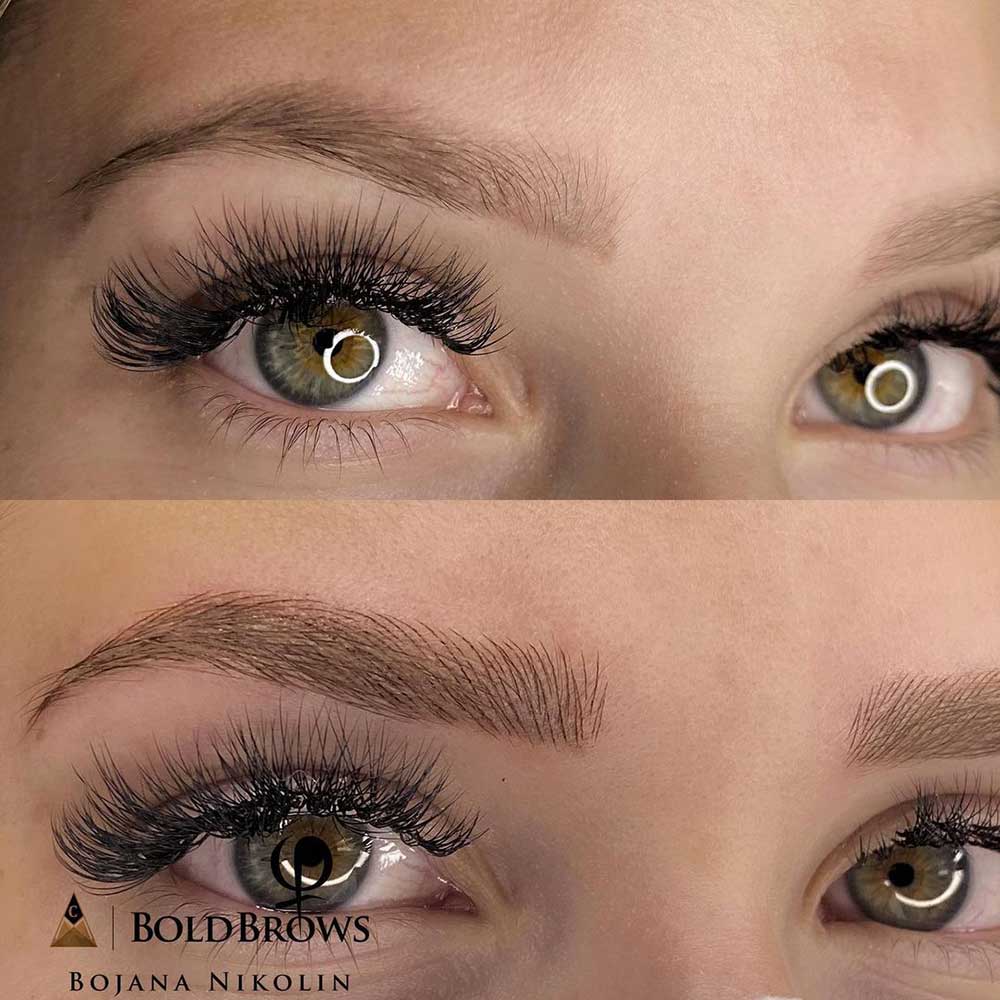
Image source : PMUhub
About Microblading Eyebrows
Is Microblading a Tattoo?
Microblading is a form of eyebrow tattoo, but somewhat different from traditional tattooing. Unlike traditional tattooing, which is done with a tattoo machine, microblading is done with a manual tool.
Another difference is the ink that is used. Traditional tattoos use tattoo ink that stays visible forever, but tends to change hue into an unattractive bluish shade. Microblading pigments (also called microblading ink) are formulated differently – the body breaks them down more easily. Therefore, microblading fades faster.
Microblading looks more natural and the pigments don’t change their hue – they just appear lighter with time.
Learn more about the differences between Microblading and Eyebrow Tattoo in our guide Eyebrow Tattoo vs Microblading: Key Differences
Is Microblading Permanent?
Even though microblading is a form of a tattoo, it is not permanent – it will fade after some time.
When it will fade depends on many factors, such as skin type, lifestyle, skincare routine, etc. On average, it is supposed to fade within 2 years, but some people still have visible residues even after 5 years.
Who Is Microblading Good For?
Microbladed eyebrows will be beneficial for:
- people who have patchy, sparse brows and want to add the illusion of fullness and thickness.
- people who are not satisfied with the shape or color of their brows – microblading will give them the shape and color to match and compliment their face features.
- anyone who uses eyebrow enhancement makeup products every day.
- people who don’t have their natural eyebrows, like people with alopecia, or people who suffer from brow hair loss caused by a number of reasons (natural hair loss, hair loss after invasive treatments such as chemotherapy, postpartum hair loss, etc.).
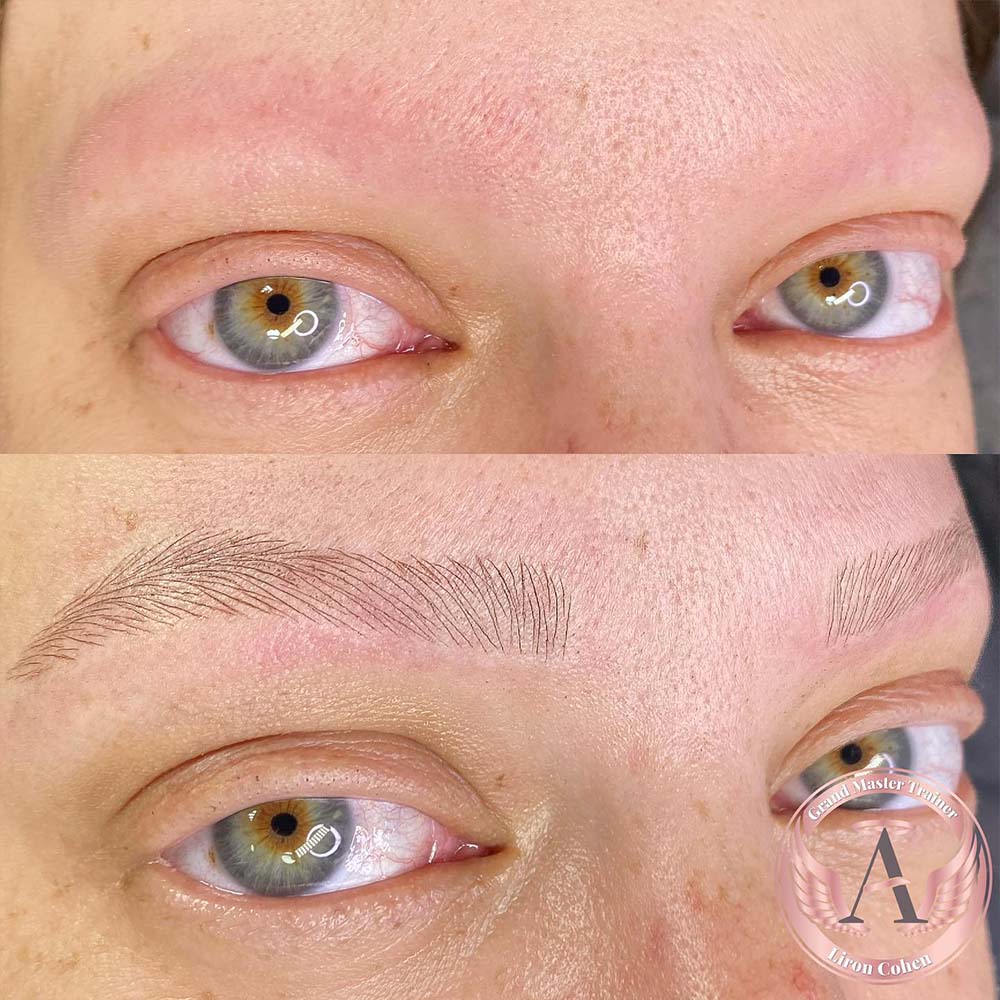
Image source : PMUhub
Who Should Not Get Microblading?
Unfortunately, microblading eyebrows isn’t safe for:
- People with some autoimmune diseases
- People who are going through chemotherapy (it’s safe to get microblading 2 months before, or around 6 months after the chemo, when your system recovers and rests, but with the doctor’s approval; read more here)
- Immunosuppressed or immunocompromised patients
- People with any bleeding disorders
- People who’ve recently had Botox injections or fillers in the area (wait at least 2 weeks before you get your brows microbladed)
- People with viral infections or diseases
- People with skin irritations, Rosacea, or Psoriasis near the treated area
- People prone to keloid scarring
- People who use Accutane (must be off for 6 months prior to appt)
- It’s generally considered unsafe for pregnant women and women who are breastfeeding.
- People with diabetes should get a doctor’s approval
- People who take blood-thinning medications (consult your doctor and see if you can pause the meds).
If you’re not sure if getting eyebrow microblading is safe for you, consult your physician.
About Microblading Procedure
Who Does Eyebrow Microblading?
Microblading is done by trained, certified, and licensed microblading artists. In order to stay safe and healthy, and get satisfactory results, never go to untrained, self-taught artists who don’t have the mentioned credentials.
So, when choosing a microblading artist, check whether they are certified and licensed (they should have the certificate displayed on the wall), and whether they work in sterile conditions, use gloves and disposable tools while working, and properly disinfect all the surfaces after every client.
Besides that, carefully research the microblading artist by checking the online reviews of their business and their portfolio of microblading before and after images on social media.
How Long Does Microblading Procedure Take?
The whole eyebrow microblading treatment usually lasts for 2-3 hours.
Consultations are usually needed before booking the appointment, and most artists book them separately from the actual treatment, a few days prior. They are usually no longer than 30 minutes. The artist will assess your skin type, ask you about any medical conditions you may have to see whether you are a good candidate for the treatment.
They will also tell you how to properly prepare for the appointment (read more about that below).
What Does the Microblading Procedure Look Like?
The actual treatment consists of several steps that usually look like this:
- STEP 1: Signing a consent form
- STEP 2: The artist prepares the area around the brows by threading the stray hair and cleaning the skin.
- STEP 3: Measuring, mapping, and outlining. The artist will show you a pre-draw to agree what your eyebrow shape will look like after the treatment.
- STEP 4: Numbing – The brow area is covered with a topical anesthetic, or numbing cream, which is left on for a certain period of time, usually 15 or 20 minutes (some artists skip this step).
- STEP 5: Preparing the pigment
- STEP 6: The blading process
- STEP 7: If there is any severe discomfort at this stage, the secondary numbing is applied after the first pass.
- STEP 8: The second pass – Some artists do more than two passes; it usually depends on the client’s skin.
- STEP 9: Cleaning, checking & photos
- STEP 10: Aftercare instructions, to make sure your eyebrows heal properly. Most artists give their clients an aftercare kit with printed instructions.
- STEP 11: Booking the touch-up appointment (learn more about the touch up below)
PMUHub Tip: Communication is important! Don’t be afraid to be vocal about your wishes, but do take the artist’s suggestions into consideration. You should ask everything you want to know about the treatment itself and the aftercare.
Does Microblading Hurt?
Even though it’s a form of tattooing and the blading is involved, most clients claim that the brow microblading treatment does not really hurt.
Numbing gel is applied to the treated area, so the actual process is more uncomfortable than painful. Some sensations you may feel are pressure, scratching, tingling, pinching, some stinging, the urge to sneeze, but probably not the actual pain.
Does Microblading Hurt?
The preparation for microblading can affect the outcome of the treatment. Follow these tips to prepare for microblading properly and ensure good healing results:
- Stop using retinol or Vitamin A products 1 month prior to the treatment
- Don’t go sunbathing or tanning for at least 7 days prior to the treatment
- Try not to work out on the day of the treatment
- Avoid alcohol, caffeine, ibuprofen, aspirin, and fish oil supplements for at least 24 hours prior to the treatment
- Don’t pluck or wax your eyebrows at least 1 week prior to the treatment
- Don’t do any facials at least 2 weeks before the treatment
- If you’ve had Botox or fillers in the area, wait at least 2 weeks before microblading.
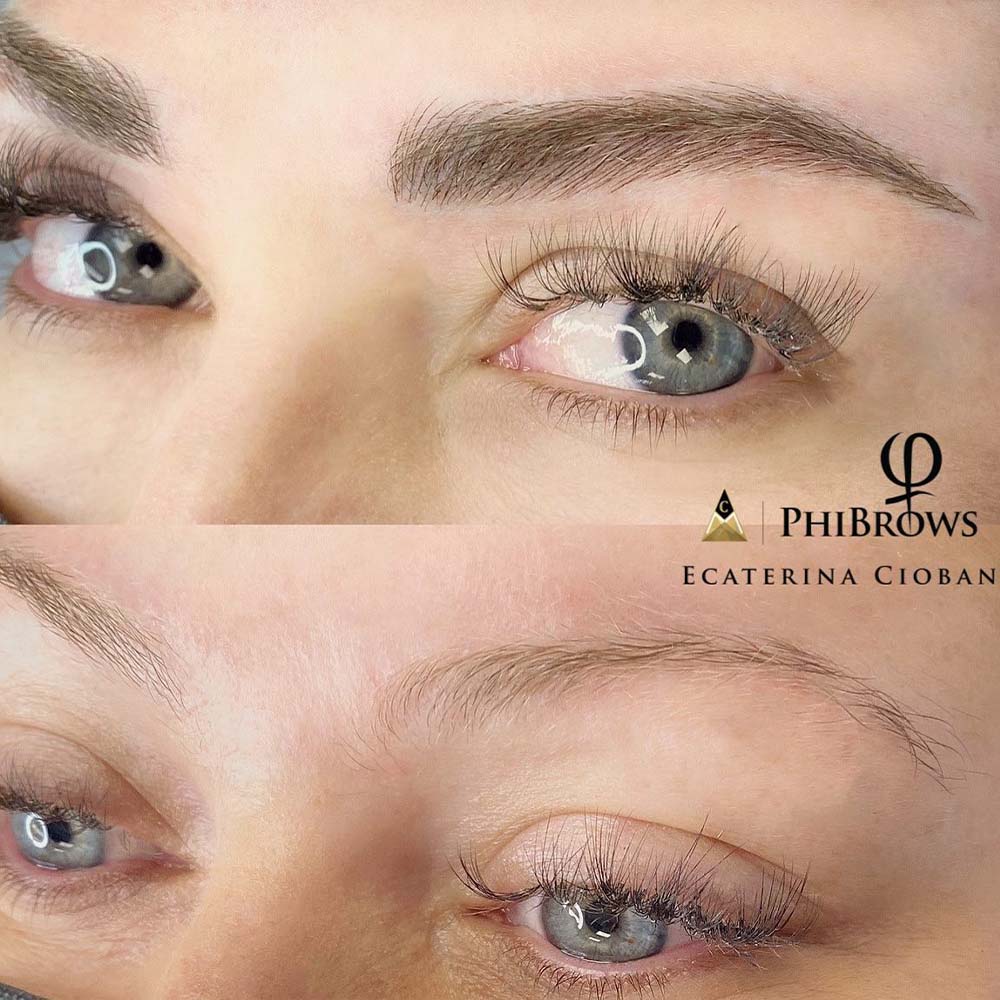
Image source : PMUhub
About Microblading Procedure
Does Microblading Hurt?
Microblading aftercare is a very important step in the process. It usually lasts up to 2 weeks, after which you can discontinue the aftercare routine and let the brows continue healing on their own.
During the aftercare period, it is important to avoid activities that will cause the brows to get soaking wet, such as swimming, long showers, going to the sauna, etc. It is important to wash your eyebrows regularly and carefully, with a little bit of sterile water and antibacterial soap and keep them dry afterward.
Your PMU artist will recommend either wet or dry healing. Wet healing means that you will be given a healing balm/ointment to apply to your eyebrows after you clean them. Dry healing doesn’t include an ointment. In both cases, washing eyebrows is a must.
Also, check with your artist which products are strictly forbidden and avoid using them.
If you don’t follow the prescribed microblading aftercare instructions, you’re not just risking ruining the results; you’re also risking your health since you can develop an infection.
How Long After Microblading Can I Wear Makeup?
It’s forbidden to wear makeup on the treated area for about 2 weeks because the treated area is very sensitive and prone to infections in the days after the procedure.
You are technically allowed to wear it on other parts of your face. However, since makeup can get to the treated area easily during the application, wearing, or removal, it is risky to wear makeup at all during the healing period.
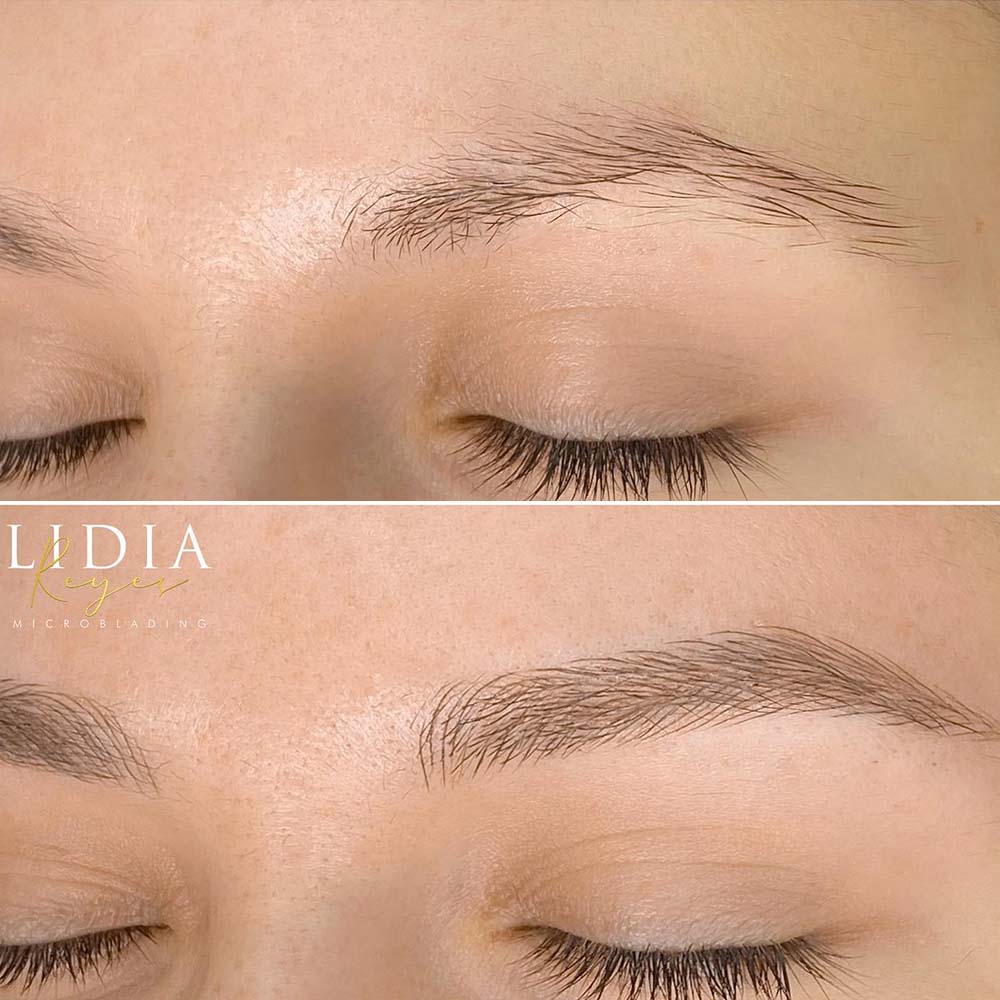
Image source : PMUhub
Microblading Healing Process
How Long Do Microbladed Brows Take to Heal?
The full microblading healing process lasts for about a month. Here’s what to expect:
Your microbladed eyebrows will probably be swollen and look too dark at first, but over the course of the microblading healing period, they will settle into the desired shape and color.
Your brows will go through the scabbing stage, which will start somewhere between days 2 and 5. Be patient and don’t pick at the scabs no matter how itchy they get!
After scabbing, your microbladed brows will start to look very light and you might feel as if they are disappearing. This is normal since your skin is regenerating and naturally exfoliating. There’s no need to worry – your eyebrows will regain their color after some time.
4 to 6 weeks after the treatment, your microbladed eyebrows might look a little patchy and uneven, which is why you need to have the mandatory touch-up.
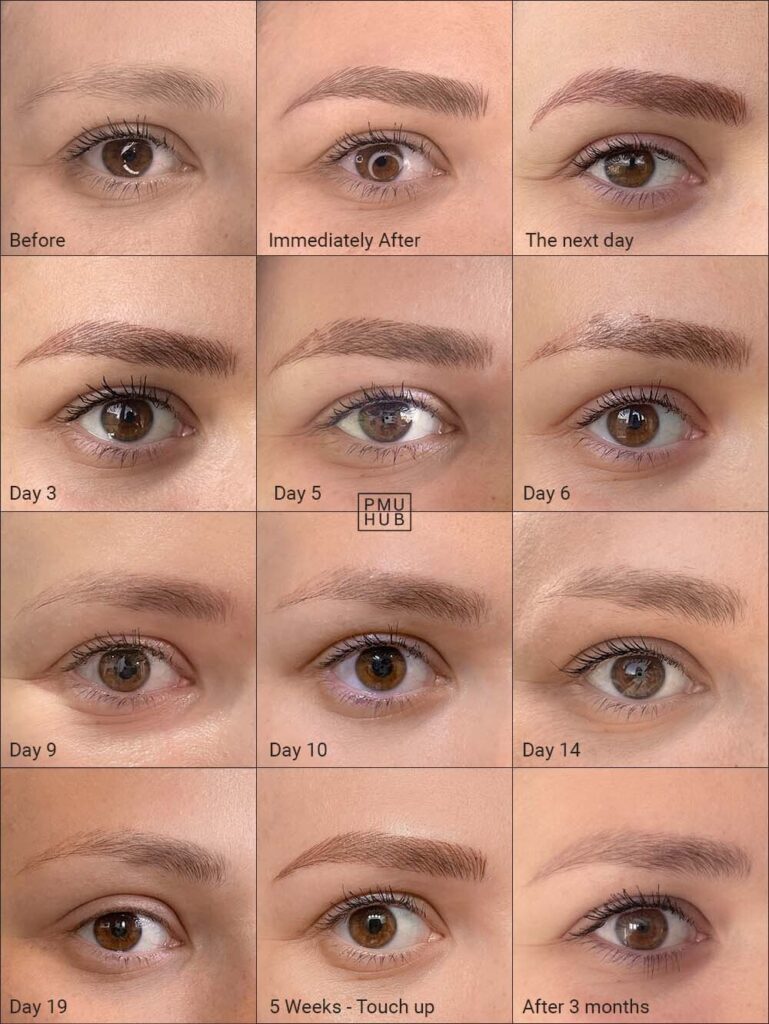
Image source : PMUhub
Microblading Touch Up
When Should I Get a Microblading Touch Up?
Microblading is a 2-step process. The first, mandatory touch up needs to be done when the eyebrows are completely healed, so no sooner than 4 weeks after the initial treatment (usually after 6-8 weeks).
How Often to Touch Up Microblading?
The frequency of touch up appointments depends on how soon your microblading fades. People with oilier skin will probably notice their microblading fades faster and they will have to book color refreshment treatment after a year.
Those with normal to dry skin will be set for longer. This also depends on the lifestyle – people who spend a lot of time in the sun, who work out or swim a lot can expect their brows to fade faster. But on average, people with normal to dry skin can expect to book touch ups after 18-24 months.
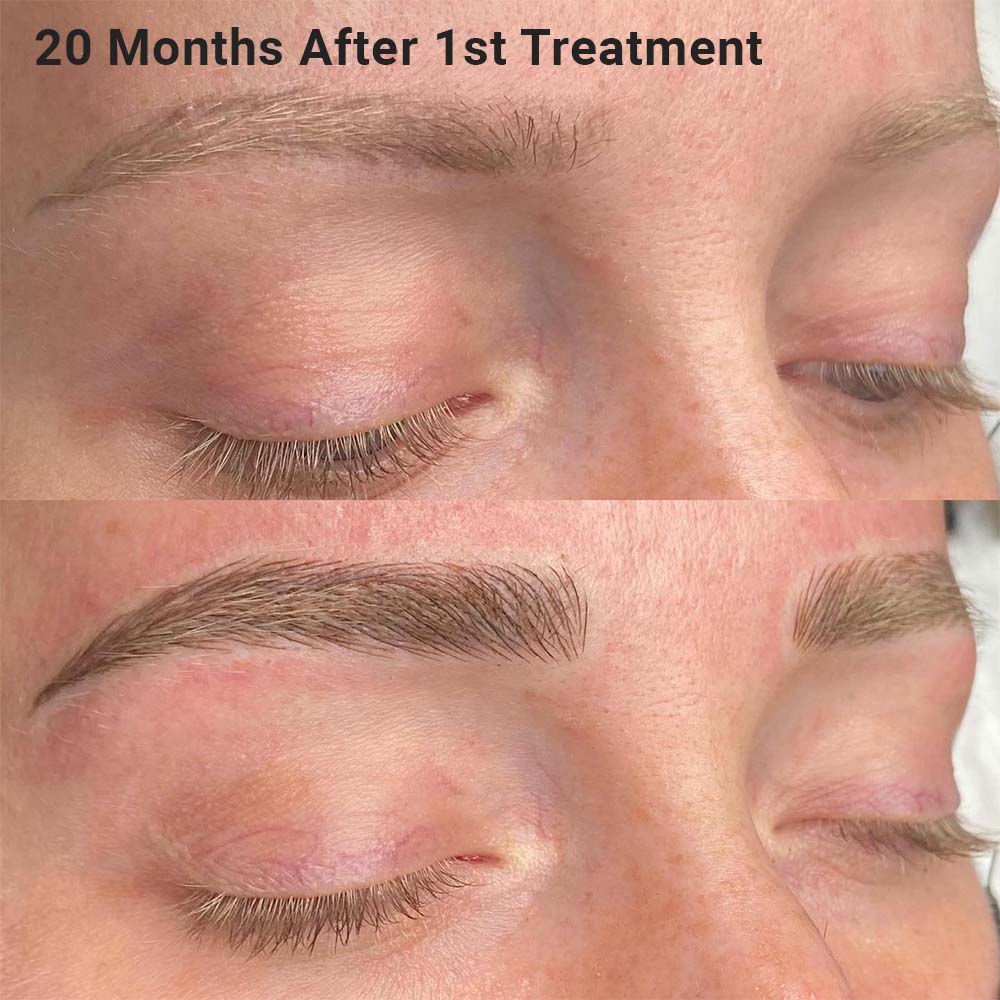
Image source : PMUhub
Microblading Side Effects
Is Microblading Safe?
Microblading is generally considered a non-invasive treatment, and is safe for most people.
That said, it does involve the breaking of the surface of the skin, and thus carries certain risks, mainly the possibility of an allergic reaction to pigments, and skin infections.
Infections are not that common, but they can happen if the tools used are not sterile, or the pigments get contaminated on their way into the skin. They can also develop in the days after the procedure, while the skin hasn’t healed.
If you choose a certified artist who works with sterile equipment, and you follow the microblading aftercare instructions they give you, there is nothing to worry about!
Potential Side Effects of Microblading Eyebrows You Might Encounter:
- Swollen eyebrows
- Eyebrows too dark
- Itchiness
- Scabbing
- Quick pigment fading (oily skin)
- Irritations
- Infections
- Allergy
Can You Have Allergic Reaction to Microblading?
Unfortunately, some people may get an allergic reaction to the treatment. If you are allergic to tattoo ink, it’s likely you will be allergic to PMU pigments, too, but this is not a rule, since PMU pigments are generally cleaner.
Also, numbing cream or the pigment itself gets into the bloodstream and causes more severe allergic reactions.
Some pigments contain Paraphenylenediamine (PPD), which is used in hair dye and which some people are allergic to. Luckily, there is a wide range of pigments available on the market, so warn your artist about the allergies and make sure they don’t use pigments with PPD.
A patch test is always recommended, to check if you are allergic to a pigment or not. Most artists do them anyway, but in case you’re prone to allergic reactions in general, definitely insist on a patch test.
It is also vital not to apply any cosmetic products or makeup onto the brows right after the treatment, i.e. before the healing period is finished, because that can lead to an allergic reaction as well, and even infections.
Does Microblading Affect Hair Growth?
Microblading neither encourages nor prevents hair growth. Don’t be afraid you’ll lose your natural brows because of microblading – it is perfectly safe.
Microblading Removal
Can Microblading Be Removed?
Yes, microblading can be removed. It is usually done if a person ends up with bad microblading eyebrows, or doesn’t like it anymore, or if the microblading hasn’t faded completely, and the persistent pigment needs to be removed before a new eyebrow tattoo treatment.
The most effective removal treatments are:
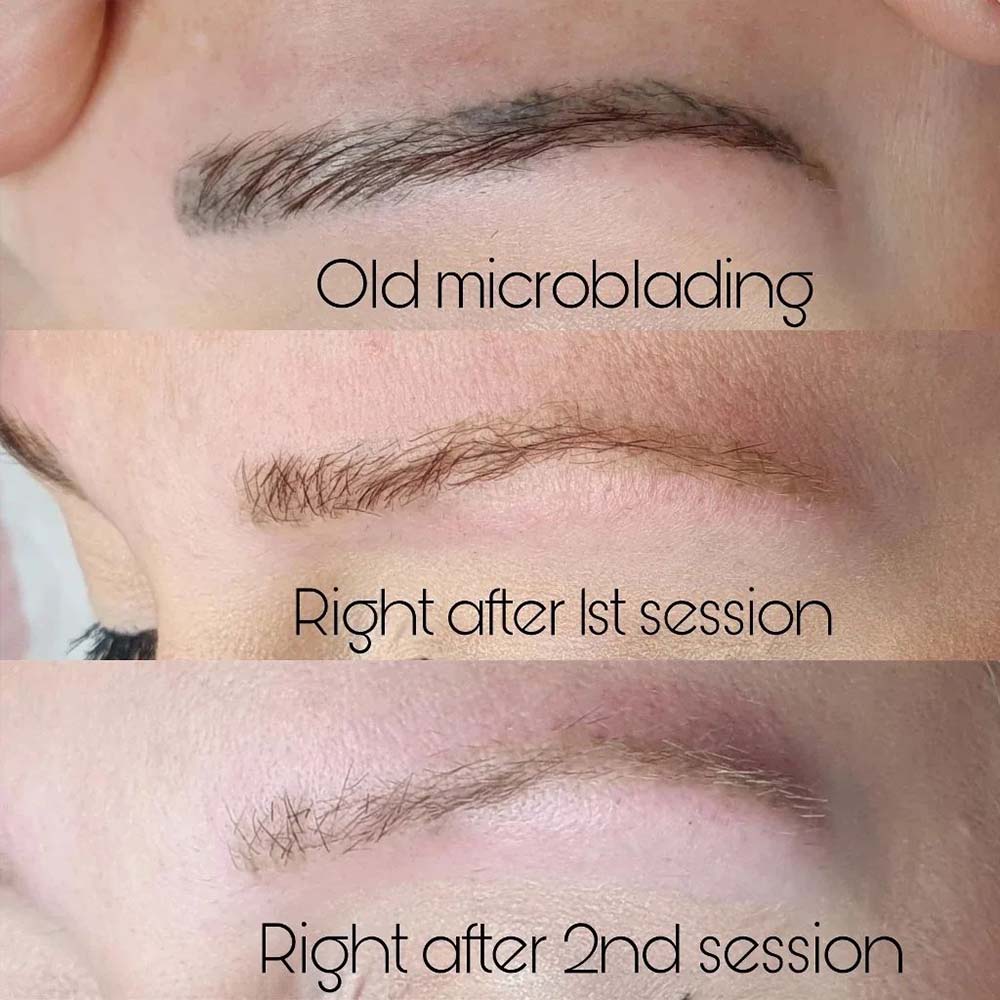
Image source : PMUhub
How Much Does Microblading Cost?
Yes, microblading can be removed. It is usually done if a person ends up with bad microblading eyebrows, or doesn’t like it anymore, or if the microblading hasn’t faded completely, and the persistent pigment needs to be removed before a new eyebrow tattoo treatment.
The most effective removal treatments are:
Benefits Of Microblading
- It will save time
- It looks extremely natural
- It’s long-lasting
- It doesn’t last forever, so you can modify the shape after it fades
- It’s low-maintenance
- It’s waterproof
- It doesn’t run or smudge
- It fixes sparse brows
- It’s customized to suit your face
- It can create brows from scratch
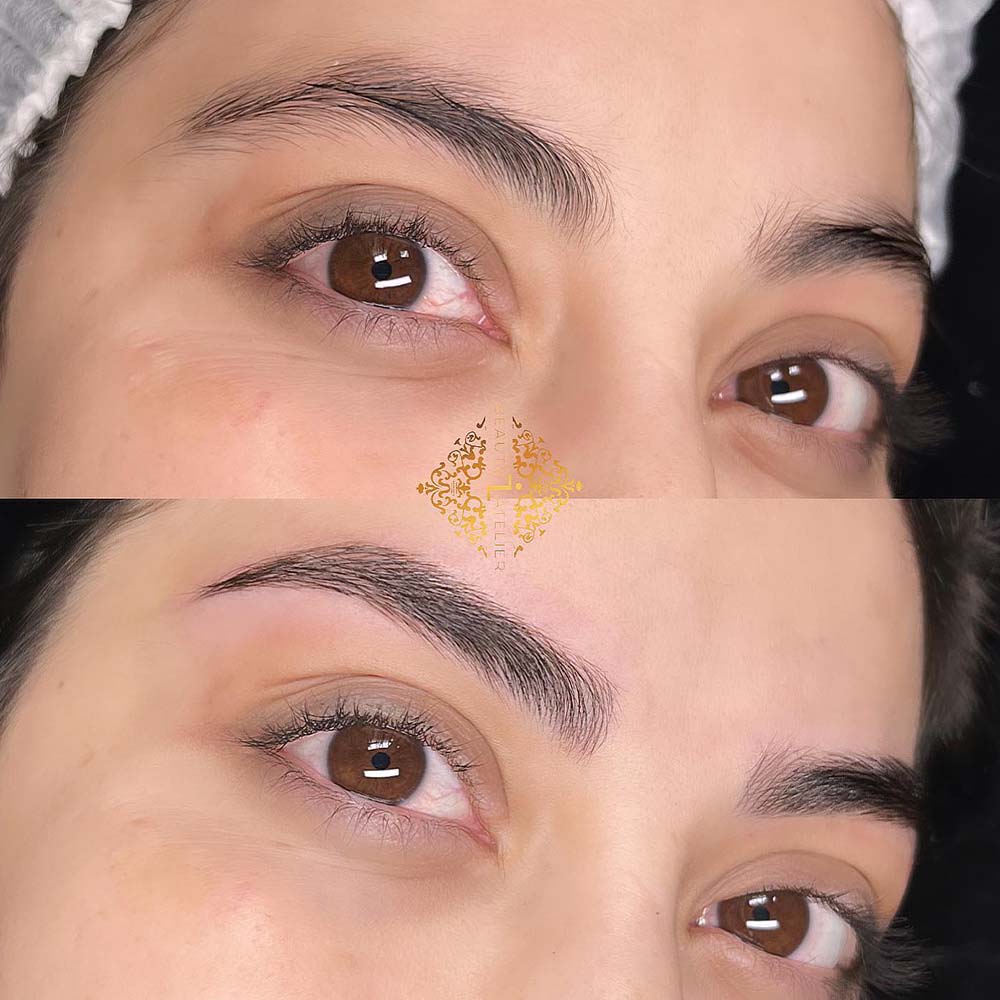
Image source : PMUhub
Microblading Popularity
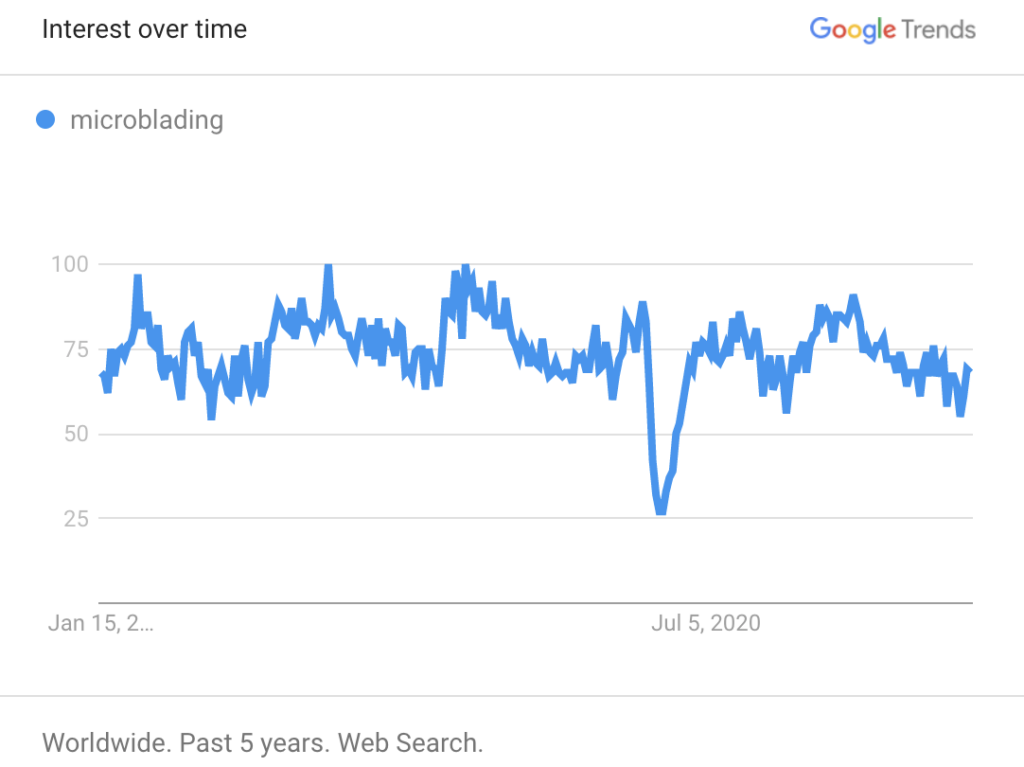
Numbers represent search interest relative to the highest point on the chart for the given time worldwide. A value of 100 is the peak popularity for the term. A value of 50 means that the term is half as popular. A score of 0 means there was not enough data for this term.
As you can see on the graph above, the term ‘microblading’ doesn’t seem to have lost any popularity over the recent years. With minor fluctuations due to COVID-19, it keeps rather high positions on the Google Trends graph.
The Rising Popularity of a New Microblading Style – Nanoblading
Relatively recently, a new type of microblades emerged on the market – nanoblades. These are the thinnest microblading blades available, with diameters ranging from 0.15 to 0.18 mm, and they make the thinnest hair strokes.
Artists started switching to nano blades so much that a new microblading style emerged quickly, and they started calling it nanoblading.
There’s no difference in the actual technique, but the results are recognizably more delicate and natural. The name stuck, and nanoblading is expected to become the new standard in the future.

Microblading – Main Takeways
Microblading is the most popular form of permanent makeup for a reason.
It saves time, boosts your confidence, fixes any small brow imperfections you may be feeling self-conscious about. And all that without reapplying, running, smudging, or worrying about your brows for up months or years!
This treatment can truly change your life, but make sure you always go to a trained, certified artist in order to stay safe and get fabulous results.
weekly insight into PMU insdustry
Subscribe to our FREE newsletter. 100% good stuff.

support us so we can keep providing you with free education , information and inspiration.
